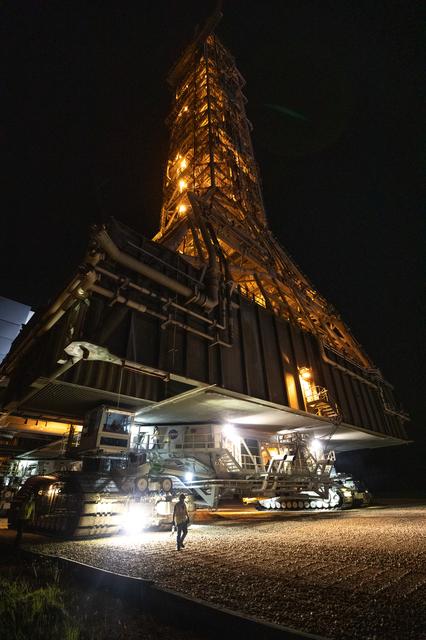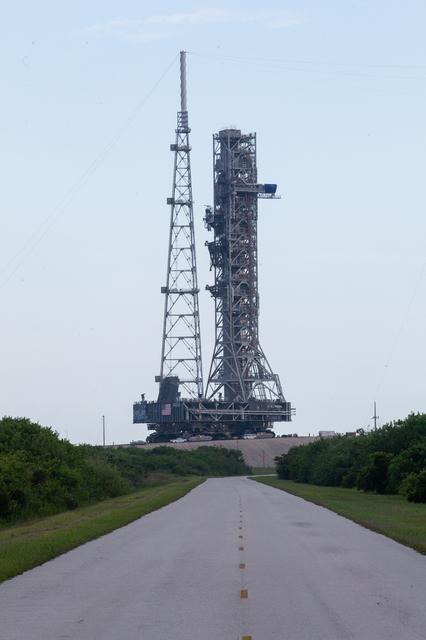“我们之前爬。”这是美国宇航局的座右铭。
The largest tracked-vehicle on the planet will move the Orion spacecraft in mid-August

If you have young children of a certain age, especially boys, you know they’re fascinated with really big machines, like trucks, trains and construction equipment. Well, I might be an adult of a certain age, but, I’m still enthralled by really big machines.
Recently, I had a chance to interviewJohn Giles, the NASA operations manager in charge of perhaps the biggest machine on the planet and certainly the biggest machine in materials handling,NASA’s Crawler-Transporter 2. Weighing in at 6.65 million pounds, with a payload capacity of 18 million pounds, it’s billed as Earth’s largest-tracked vehicle. Consider it the Argentinosaurus of machines, an AGV like no other. “You have no idea until you stand next to it just how big it is,” says Giles, whose official title is Crawler Element Operations Manager, Exploration Ground Systems, NASA’s John F. Kennedy Space Center. It’s a big title befitting a guy who oversees such a big machine, which he’s done for ten years. You canclick hereto view a video link from Business Insider.
如果NASA坚持8月15日发射时间表,the crawler will begin a journey in the middle of the night around August 9 from the Crawler yard, where the vehicle lives, to the launch pad. It’s only 4.2 miles– I’ll walk you through the details in a moment – but it takes between 8 and 12 hours, with the vehicle traveling at about 1 mile per hour. Fuel efficiency wasn’t a priority when the vehicle was designed: The Crawler will burn about 530 gallons of diesel on the trip. Given the price of diesel at the pump, you can do the math. Driving the thing is not without stress given the size of the payload and the precision required to position it to within a quarter of an inch at the launching pad. Giles says that NASA swaps out operators every 45 to 60 minutes.
The crawler has a storied history. Like the B-52 bomber, which was first put into service in 1952 and is still on the job, the Crawler has been delivering payloads for NASA since the 1960’s. “I like to tell people that while we’ve completely rebuilt the launchpad and the Vehicle Assembly Building (VAB), where we build the space craft, the thing that takes us to the pad is a 57-year-old piece of equipment that still works today,” Giles said.
Even more impressive, the original design by the Marion Power Shovel company with components from Rockwell International was done on paper with state-of-the-art tools circa 1964: Pencils, T-squares and slide rules. Two crawlers were originally built to move the Apollo Saturn V moon rocket at a cost of $16 million each. When they were assembled on site at the Kennedy Space Center in 1965 – they were too big to transport – they were the largest self-powered land vehicles in the world. The first mission was on August 26, 1967, when a crawler was used to transport a space craft from the VAB to a launch pad for an Apollo 4 mission.
The Apollo program called for a 12-million pound payload. But when the shuttle program ended, NASA realized the next launch vehicle “was going to be bigger than anything we’d ever done. We were given a target weight of 18 million pounds, which was 50% more than it was designed for,” said Giles. To make that happen, NASA installed a new braking system, new gear boxes and additional welded steel. The project took 2-1/2 years to complete. “When the Ames Research Center scientists came out to evaluate the vehicle, they realezed the original designers had given us multiple safety factors, which allowed us to modify the vehicle,” Grimes said.
Today, the crawlers are maintained and operated, by theJacobs Engineering Group, which also trains and employs the drivers. And, not just anyone can be a driver. For starts, a driver has to be an engineer from an accredited institution. Before they can drive, drivers must learn how to operate, troubleshoot and maintain the hydraulic, mechanical and electrical systems and put time in the control room. If they get through that, they’re eligible to go to driver school and learn how to maneuver the vehicle on the straightaways, the curves, the docking and most importantly, the 5 degree incline that leads up to the launch pad, the most harrowing part of the trip. “It takes a good two years to become a certified driver,” Giles said.
Back to the journey. As we said, it begins in the middle of the night a good two or three days before the launch. From the crawler yard, the vehicle goes to the VAB, a 550-foot tall building where the space craft are assembled, to pick up its load. The space vehicle is assembled on top of its mobile launch platform, so the crawler rolls underneath. When it does, the team begins the process of jacking the launch platform up 18 inches to transfer it onto the crawler. That takes about half an hour, with a couple dozen people stationed around the perimeter to watch for danger.
Once the mobile launch platform and the vehicle are in place, the crawler begins its plodding journey to the launch pad. By the time it reaches its destination, hours have passed, drivers are exhausted, everyone is tense, and now the most stressful part of the trip begins. “When we get to the bottom of the launch pad, we have to travel up the incline slope,” Giles said. “It has to be precise, or we have to roll it back down the incline and start over.” There are gravity and leveling issues. The engines have to be operating at peak performance and the driver is guided by a laser to perfectly line up where it needs to be on the pad. In the old days, before lasers, they used a rope.
Once the vehicle is in place, things have to be connected and disconnected so the rocket can be removed from the platform. Once all of that is done, the team gets the signal that they can lower the space vehicle in place. That takes at least half an hour, followed by more connections and disconnections before the crawler rolls down the hill with the empty mobile launch platform as a payload.

The crawler at the launch pad.
But the team is not done yet. The crawler will remain outside the pad gate for the next two to three days to make sure that everything is a go. From there, it waits at a mobile service structure about halfway between the launch pad and the crawler yard until the launch takes place. Finally, once the vehicle is in the air, the mobile launch platform is returned to the VAB and the crawler to the storage yard. Basically, it’s about 4 days to complete a round trip of about 10 miles.
团队的十年后,我问贾尔斯sta什么yed with him the most. He said it was the fact that they could be so precise with something so huge. “Our tolerances are tight,” he said. “We have to be within a quarter of an inch of where we’re supposed to be, or we have to spend a half an hour to roll back down the hill and try again,” he said. “Thankfully, we usually get it right.”
He added, “When you’re next to this beast when it’s running, it’s constant noise, vibration, dust and heat. If ou’re a mechanic or an engineer, you’re right at home. It’s a wonderful piece of equipment.”

Article Topics
Latest in Logistics
U.S. Chamber of Commerce calls on the White House to appoint a mediator to resolve ILWU-PMA standstill Tale of Two Loads: LTLs managing reduced demand better than TL carriers U.S. rail carload and intermodal volumes are mixed in May, reports AAR WMS + OMS: Maximize ROI & Win Customers for Life Better wages in works as ABF, Teamsters reach tentative five-year deal New Port Tracker report signals more U.S.-bound import declines over the rest of 2023 DHL eCommerce moves into a new Missouri-based facility More LogisticsAbout the Author
Subscribe to Logistics Management Magazine

Find out what the world's most innovative companies are doing to improve productivity in their plants and distribution centers.
Start your FREE subscription today.
June 2023
万博2.0app下载

Latest Resources














